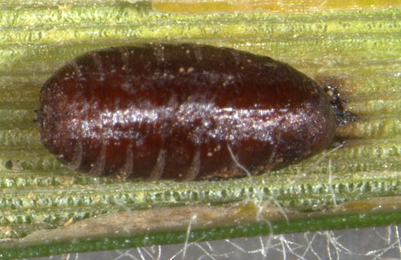|
||||||
| Cerodontha
eucaricis Nowakowski, 1967 [Diptera: Agromyzidae] |
||||||||||||||||||||||||||||||||||||||||||||||||||||||||||||||||||||||||||||||||||||||
|
Cerodontha
(Butomyza) eucaricis Nowakowski, 1967.
Polskie Pismo ent. 37(4): 636 |
||||||||||||||||||||||||||||||||||||||||||||||||||||||||||||||||||||||||||||||||||||||
|
Leaf-miner: Linear mine. Pupation either in the leaf at end of mine or externally (Spencer, 1976: 207). Mine upper-surface, in the central part of the blade. Frass in a few large lumps; often all frass still is contained in the larva's intestine. Larva solitary. Puparium in the mine, fixed ventrally with dried frass (Bladmineerders van Europa). Larva: The larvae of flies are leg-less maggots without a head capsule (see examples). They never have thoracic or abdominal legs. They do not have chewing mouthparts, although they do have a characteristic cephalo-pharyngeal skeleton (see examples), usually visible internally through the body wall. Puparium: The puparia of flies are formed within the hardened last larval skin or puparium and as a result sheaths enclosing head appendages, wings and legs are not visible externally (see examples). Dark brown; posterior spiracles arising from a common projection, one bulb being long, hook-like, with the lower two ones small (Spencer, 1976: 207). The puparium is illustrated in Bladmineerders van Europa.
Hosts in Great Britain and Ireland:
Hosts elsewhere:
Time of year - mines: June to September (Bladmineerders van Europa). Time of year - adults: Currently unknown. Distribution in Great Britain and Ireland: Huntingdonshire (Woodwalton Fen), Surrey and Glamorgan (Spencer, 1972b: 100). Distribution elsewhere: Not uncommon in Europe including Sweden, Finland, Germany, Poland (Spencer, 1976: 206), The Netherlands (Bladmineerders van Europa), Belgium (Scheirs, de Bruyn and von Tschirnhaus, 1999), Germany (Spencer, 1976: 554), Czech Republic, French mainland, Hungary, Lithuania, Poland and Slovakia (Fauna Europaea). Also recorded in Canada (Spencer, 1976: 206). NBN Atlas links to known host species:
British and Irish Parasitoids in Britain and elsewhere:
|
|
|
|
| External links: | Search the internet: |
|
Biodiversity Heritage Library Bladmineerders van Europa British leafminers Encyclopedia of Life Fauna Europaea NBN Atlas NHM UK Checklist |
Find
using Google Find using Google Scholar Find images using Google |
| Last updated 09-Jul-2019 Brian Pitkin | ||

